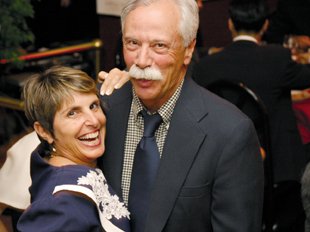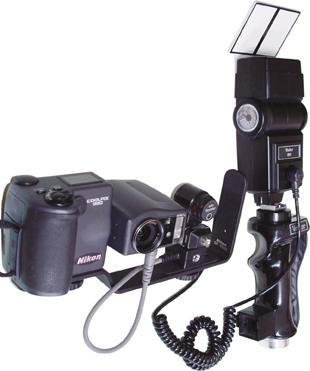Hack 42 Bounce Flash for Softer Light
| < Day Day Up > |
| One of the best techniques for using (and reasons for purchasing) an external flash is to bounce its light off the ceiling. This creates softer skin tones and a journalistic look . Photographer Bill Harvey was awarded the lifetime achievement award in 1997 by the Press Photographers Association of Greater Los Angeles. He showed me the setup that I still use with unfailingly excellent results, as everyone always agrees. Bill used a Vivitar 283, still available today, mounted on a pistol grip. With the 283, you just set the ISO, switch the removable sensor to one of several distance settings, and look up the color -coded distance setting on the illuminated dial to find the correct f-stop. But Bill never shot the flash directly at his subject. Instead, he pointed it upward, toward a small plastic reflector like the one in Figure 4-5, made by Sto-Fen (http://www.omni-bounce.com). Sto-Fen makes several accessories for the 283, as well as Canon and Sunpak strobes. Figure 4-5. The Sto-Fen reflector for bounce-flash photography (photo by Mike Pasini) Bill used Sto-Fen's Twin Panel Bounce. Its compact, clever design eliminates hot spots and covers 24mm lenses and larger. Digicam zooms generally aren't wider than 28mm (speaking in 35mm equivalents). I also like their Omni Bounce, which is a white plastic dome with a black panel on the back that sits right on top of the 283 lens. It gives an even softer shadow than the Twin Panel but doesn't have quite the range. Both bounces come with a black plastic mount that just snaps over the 283very simple, elegant, portable, and reliable. If the head of your flash pivots upward, you can also bounce the light from your flash with a rubber band and the back of a business card. This disperses the illumination . Some flashes even include a bounce card built into the head. Bounce flash gets you soft, natural shadows over a wide area and completely eliminates red eye, as shown in Figure 4-6. Figure 4-6. Using bounce flash to produce more natural results The 283's removable light sensor is an important feature. You can mount the removable sensor on the camera's hot shoe but move the light around to other positions and still get good exposures. In Figure 4-7, I've rigged up a Vivitar 283 to a Nikon CoolPix 990. This isn't sophisticated dedicated flash circuitry precision, but it keeps the sensor with the camera; after all, that's where the exposure is made. Figure 4-7. Vivitar 283 with Nikon CoolPix 990 (photo by Mike Pasini) Bill would add an external battery pack to power his Vivitar, but I find that today's NiMH AA rechargeables handle the job with power to spare. I like to move the flash an arm's length away, up high or even to the other side of the camera, depending on the subject. I know the sensor will adjust to whatever I want to do, rather than force me to do something the flash expects. I can comfortably wave the flash around, because it's mounted on a nice, molded Vivitar grip. The grip pops on and off a bracket that attaches to the camera via its tripod mount. It couldn't be simpler. The whole rig is a bit ostentatiousit makes me look like I actually know what I'm doingbut it's actually easy and natural to use. And it's a lot of fun to be able to paint the picture with the light of the flash. 4.5.1 One Important Catch for Digicam UsersThe problem with the popular 283, apparently (it's hard to confirm this from any reliable source), is that models manufactured before 1984 use a trigger voltage of 200-300 volts. Models since then use a less titillating 10 volts, which is under the 12 volts most autofocus SLRs warn against. Digicams with hot shoes prefer things a little less exciting, generally under 6 volts . Sending more than that through your digicam's delicate circuits might eventually fry them. To protect my digicams, I use the tiny, US$40 Wein Safe-Synch HS voltage regulator . I found mine at B&H Photo (http://www.bhphotovideo.com). The Wein slips into a hot shoe and is tightened safely into place with a thumb wheel. You can connect your flash to the Safe Synch's PC connector or the hot shoe to enjoy its six-volt-maximum trigger-voltage protection. 4.5.2 A More Modern ApproachI thought you'd enjoy Bill's story, because it shows that the bounce-flash technique has been making photographers look good for decades. Thanks to modern technology, however, this magic is easier than ever to use for your pictures. If your digicam accepts an external flash made by its manufacturer, you can apply the art of bounce with the brains of dedicated flash circuitry. In Figure 4-8, I've connected an Olympus C-5050 with an Olympus FL-40 flash via a dedicated remote cord. Why is this important? Because the intelligent exposure system takes all the guesswork out of getting a perfectly exposed shot. You simply put the dedicated flash in the camera's hot shoe, point the flash head up to the ceiling, compose your picture, and take the shot. Figure 4-8. Olympus C-5050 with bounce flash The camera opens the shutter and fires the flash. As the light bounces off the ceiling and rains down on the subject, the camera measures the light as it passes through the camera lens. When there's enough light for a proper exposure, the camera turns off the flash and closes the shutter. All of this magic happens in a fraction of a second, and it works beautifully. I've successfully used this technique with a Canon G2 camera with matching Canon 420 EX Speedlite flash, and with an Olympus C5050. But Nikon, Minolta, and many other manufacturers make similar rigs, and they all work wonderfully. 4.5.3 No Hot Shoe, No Problem! (Well, Sort Of)But what if your camera doesn't have a flash hot shoe? Does that mean you're doomed to harsh , unflattering indoor photography? Not at all. First, read [Hack #41] . That will help you get an external flash talking to your camera. However, as mentioned in that hack, you don't have the advantage of the camera's dedicated flash circuitry controlling the light output to ensure a good exposure. You're in uncharted waters here. As a starting point, set the external flash to its maximum output setting so you have as much light as possible to bounce off the ceiling. If your camera has a Manual Exposure mode, set the shutter on 1/30 of a second and set the aperture at f-4. Bump up your ISO setting from 100 to 200, just to make the image sensor a tad more sensitive. Now, point your flash upward, compose the subject in the camera, and fire! Review the image in your camera's LCD monitor. If it's too bright, close down the aperture to f-5.6. If it's too dark, open up the aperture to f-2.8. If it's still too dark after you do that, you might have to increase the ISO setting to 400. As you can see, this rig requires lots of fiddling around to get just the right combination of settings. It becomes a powerful argument for investing in a dedicated flash system for your next camera outfit purchase. But until that blessed day comes, you'll be surprised at the great images you can capture once you nail the settings. Oh, and when you do, be sure to write them down. 4.5.4 A Few Bounce-Flash TipsUnlike direct illumination, bounce flash is influenced by the surface you use to reflect the light. So there are a few things to keep in mind to improve your results:
If you follow these tips, regardless of whether you have a sophisticated dedicated flash system or a simple external flash triggered by your camera's built-in flash, you'll be rewarded with outstanding images unlike anything you could capture with the direct illumination from your digicam's built-in flash. Mike Pasini and Derrick Story |
| < Day Day Up > |
EAN: 2147483647
Pages: 161